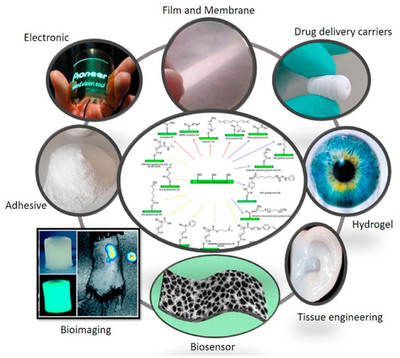التعديلات السطحية لبلورات السليلوز النانوية: العمليات والخصائص والتطبيقات

يسلط الضوء
• التحلل المائي الحمضي للسليلوز يقدم مجموعات كبريتات على سطح بلورات السليلوز النانوية (CNCs) ، مما يحد من تطبيقاتها.
• يعد تعديل السطح طريقة فعالة للتخفيف من أوجه القصور في CNCs.
• تم تلخيص التطورات الأخيرة في تعديلات السطح الفيزيائية والكيميائية.
• تطبيقات CNC ، بما في ذلك مركبات البوليمر النانوية ، تمت دراستها بشكل مكثف.
الملخص
زاد الاهتمام بالنانوسليلوز مؤخرًا في العديد من المجالات بسبب وفرته الطبيعية وخصائصه الميكانيكية / البصرية الاستثنائية وتوافقه الحيوي الأفضل. أثناء إنتاج بلورات السليلوز النانوية (CNCs) عن طريق التحلل المائي لحمض الكبريتيك ، يتم إدخال مجموعات الكبريتات ، مما يقلل من الاستقرار الحراري لشبكات CNC ، وبالتالي يكون لها تأثير سلبي عميق على التطبيق المحتمل لأجهزة CNC في المركبات النانوية. أيضًا ، تُظهر الطرق الميكانيكية خواصًا مورفولوجية رديئة في CNC مع درجة تبلور منخفضة. لذلك ، من أجل تحسين قابلية المعالجة والأداء لأجهزة CNC وتوسيع نطاق تطبيقاتها الصناعية وجودتها ، يخضع النانو السليلوز لتعديلات سطحية بوسائل فيزيائية وكيميائية. تعمل التعديلات السطحية على CNC على خفض الطاقة السطحية ، وزيادة كره الماء ، وتحسين الالتصاق البيني ، وتعزيز توافقها بين مكونات المركبات النانوية ، وتحسين تشتتها وتفاعلها. تمتلك CNC المعدلة السطحية تطبيقات واسعة في الطب ، والحفز ، والبصريات ، وعمليات المعالجة ، والإلكترونيات ، والمنسوجات ، ولب الورق ، والورق ، وما إلى ذلك. التطبيقات الأخرى لأجهزة التحكم عن بعد هي: المحفزات الداعمة وأجهزة الاستشعار ، مثل أغشية في سماعات الأذن ؛ لهندسة الأنسجة ، السقالات ، للورق المقوى ، كمركبات نانوية بوليمرية لتطوير الأغشية ، في ألواح مرنة لشاشات العرض المسطحة ، في التطبيقات البصرية ورغوات المحاكاة الحيوية ، وكمعدلات ريولوجيا. توفر هذه المراجعة أحدث التطورات في تعديل سطح CNC والعمليات والخصائص والتطبيقات ذات الصلة.
https://www.sciencedirect.com/science/article/abs/pii/S0268005X22002090
Surface modifications of cellulose nanocrystals: Processes, properties, and applications
Highlights
<!--Acid hydrolysis of cellulose introduces sulfate groups on cellulose nanocrystals (CNCs) surface, limiting their applications.
<!--Surface modification is an effective method to mitigate the shortcomings of CNCs.
<!--Recent advancements in physical and chemical surface modifications are summarized.
<!--The applications of CNCs, including polymer nanocomposites, are intensively studied.
Abstract
The interest in nanocellulose has recently increased in many fields due to its natural abundance, exceptional mechanical/optical properties, and better biocompatibility. During the production of cellulose nanocrystals (CNCs) via sulfuric acid hydrolysis, sulfate groups are introduced, which decrease the thermal stability of CNCs and, thus, have a profound negative effect on the potential application of CNCs in nanocomposites. Also, mechanical methods exhibit poor morphological properties in CNCs with a reduced degree of crystallinity. Therefore, to improve the processability and performance of CNCs and extend their industrial applications and quality, nano-cellulose undergoes surface modifications by physical and chemical means. Surface modifications of CNCs lower the surface energy, increase hydrophobicity, improve interfacial adhesion, enhance their compatibility between nanocomposite components, and improve their dispersion and interaction. Surface-modified CNCs have wide applications in medicine, catalysis, optics, remediation processes, electronics, textiles, pulp, paper, etc. Other applications of CNCs are: supporting catalysts and sensors, as diaphragms in earphones; for tissue engineering, scaffolds, for toughened paper, as polymer nanocomposites for developing membranes, in flexible panels for flat panel displays, in the optical application and biomimetic foams, and as rheology modifiers. This review provides the latest advances in surface modification of CNCs and the relevant processes, properties, and applications.
Keywords
Cellulose
Nanocrystals
Surface modification
Applications
Fabrication
Food Hydrocolloids; Volume 130, September 2022, 107689



ساحة النقاش